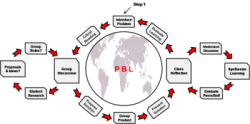Problem Based Learning
Problem Based Learning

Short description
With Problem Based Learning (PBL) the core concept is to introduce a problem to the learners and solve that as part of the learning process.
Process description
PBL is a label covering several learning methods that share a common idea where the learners are presented with a problem that they need to solve with the skills and knowledge gained from the course.
The problem does not have to be a problem; it can also be a posed question, a contradiction, an unexplained phenomenon, or something that makes the learners wonder.
While there are several different and unique ways of applying PBL, there are five specific approaches that show how to apply PBL to most situations.
1. Lecture-based cases
The teacher presents a case to provide perspective on the lecture and show how it can be used in practice. The students do not need to reflect on the case or acquire information independently, as the teacher is going over the case for them.
2. Case-based lectures
The students are presented with one or more cases that will be used to highlight the information in an upcoming lecture. The learners are to examine the cases before the lecture with the knowledge they have before the lecture, and then the teacher will go over these cases using the new information at the lecture.
3. Case method
The students are given a full case, with all the relevant information ahead of the lecture and must set up their own hypotheses about the case and analyze it. This analysis of the case is then discussed in class with the teacher giving feedback on the work done by the students. Through this discussion, the students reflect on the case with the aid of the teacher using the methods and information that the teacher intended to introduce.
4. Modified case-based
This method has the students go over a case, much like the Case method, but the students are allowed and expected to choose their own approaches and methods. Usually the students work in small groups and discuss the case internally before the lecture where they discuss it with the class and teacher.
5. Problem-based
The students are presented with a problem, which they must form their own hypotheses about and use their problem solving skills to find a solution. The teacher’s role is to advise the students in their information search and can try to remind the students what they’ve already learned and how it could be used with their current hypothesis. The major difference with this compared to the previous four is that in this approach, it is the students controlling what the hypothesis is, and how to approach it.
A variant of the problem-based approach is the closed loop/reiterative problem based approach. In addition to everything from the problem-based approach, the students are asked to reflect on how they reasoned through the problem and if they would have done it differently with what they’ve learned from the problem solving. The cycle of solving a problem, and reflecting on it and finding a new solution can be repeated many times, each time adding a new layer of knowledge.
Required resources
PBL mainly requires time and manpower. It requires more preparation time than classic lectures. Each approach requires more preparation time, with the lecture-based approach requiring the least and the closed loop/reiterative problem-based approach the most.
Comments
This example is developed in relation to the two EU projects COMBLE (https://www.comble-project.eu)
PSI: https://psi.methopedia.eu/learning-activity/problem-based-learning


